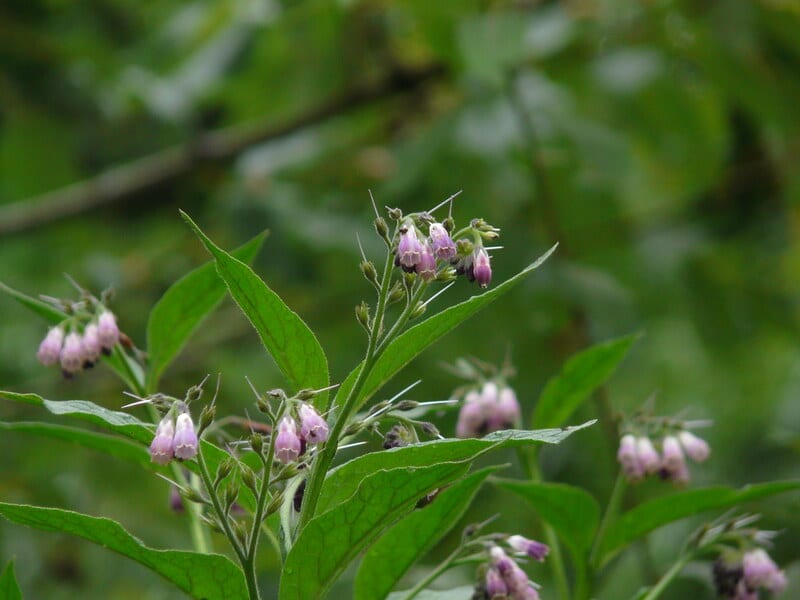Comfrey, Common Comfrey, Quaker Comfrey, Russian Comfrey
Symphytum officinale

🌿 Morphology
🌞 Growing conditions
🌍 Origin and family
🌾 Uses
Warning: Despite the care taken in writing this sheet, it is essential to cross-reference sources before using or consuming any plant. When in doubt, consult a qualified professional
Permaculture uses
Comfrey is a dynamic accumulator, bringing nutrients to the surface and improving soil fertility. Its leaves can be used as a green manure, compost activator, or mulch. It's also a valuable fodder crop for livestock. Some cultivars, like 'Bocking 14', are sterile and spread less aggressively. Medicinally, it has been traditionally used to heal wounds and broken bones, though internal use is cautioned due to the presence of pyrrolizidine alkaloids.
Permapeople description
Comfrey is a perennial herb renowned for its medicinal properties and its role in organic gardening and permaculture. Native to Europe and parts of Asia, comfrey has been cultivated globally due to its versatility and usefulness.
Historically, comfrey has been used in traditional medicine for its healing properties. It contains allantoin, a compound known to aid in wound healing, reduce inflammation, and stimulate the growth of new cells. Traditionally, it has been used in poultices and ointments to treat bruises, sprains, and other injuries. However, it's important to note that comfrey contains alkaloids that can be harmful if ingested in large quantities, and its internal use is controversial and often discouraged.
Comfrey's deep roots are excellent at mining nutrients (especially potassium) from deep within the soil, making these nutrients available to other plants when its leaves decompose. This quality makes comfrey an excellent companion plant in orchards and gardens. Its leaves are often used as mulch or added to compost piles to accelerate decomposition and add rich nutrients.
Comfrey is also beneficial for attracting pollinators and beneficial insects due to its flowers, enhancing the overall health of the garden ecosystem. Moreover, it's used as a “chop and drop” mulch in permaculture, where its leaves are regularly cut and left on the ground to decompose and enrich the soil.
Comfrey is relatively easy to grow and can thrive in a range of soil types, though it prefers moist, well-drained soil. It can tolerate partial shade but grows best in full sun. Once established, comfrey is drought-resistant and requires minimal care. It can be propagated easily from root cuttings, but due to its ability to spread, it's often recommended to grow a sterile hybrid variety like Bocking 14 (Symphytum × uplandicum 'Bocking 14') to prevent it from becoming invasive.
Botanical description
Symphytum officinale is a perennial herbaceous plant belonging to the Boraginaceae family. It grows up to 4 feet tall, with a thick, hairy stem and large, lance-shaped leaves. The flowers are typically bell-shaped and can be purple, pink, or white, blooming in clusters. It possesses a deep taproot, allowing it to access nutrients from deep within the soil. The fruit is a nutlet.
Companion planting
Comfrey is a good companion plant for many crops, providing nutrients and attracting beneficial insects. It is particularly beneficial near fruit trees, vegetables, and herbs. Its large leaves can also provide shade for smaller plants. There are no known significantly unfavorable associations.
Propagation methods
Comfrey can be propagated by root cuttings, crown division, or seed. Root cuttings are the most reliable method, especially for named cultivars. Seeds are viable but may not produce plants true to type. Crown division is also effective, especially in spring or autumn.
History and traditions
Comfrey has a long history of medicinal use, dating back to ancient Greece and Rome. Its name, Symphytum, comes from the Greek word 'symphyo', meaning 'to unite' or 'grow together', referring to its traditional use in healing fractures. It was commonly used in traditional herbal medicine for wound healing, bone setting, and treating respiratory ailments. In some cultures, it was also used as a vegetable, though this is now less common due to health concerns.
Usage calendar
Flowering occurs from May to September. Harvesting leaves for compost or mulch can be done throughout the growing season. Planting is best done in spring or autumn. Pruning can be done after flowering to encourage new growth.
